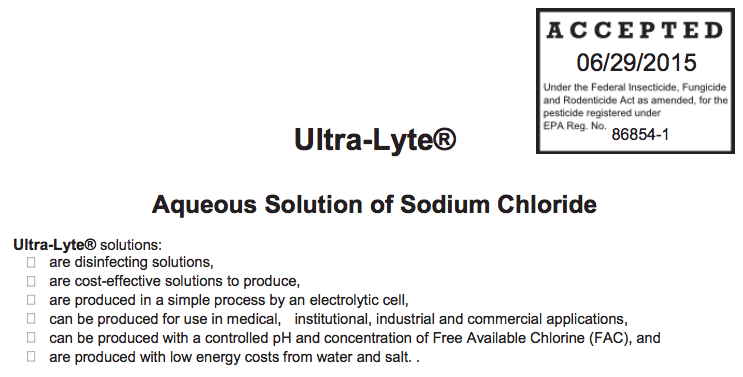CLARENTIS to launch ECO MINI
 Saturday, October 1, 2016 at 1:59PM
Saturday, October 1, 2016 at 1:59PM
October 1, 2016
 Saturday, October 1, 2016 at 1:59PM
Saturday, October 1, 2016 at 1:59PM
October 1, 2016
 Saturday, October 1, 2016 at 1:52PM
Saturday, October 1, 2016 at 1:52PM Poster Presentation Guide. NoroCORE Full Collaborative & Stakeholders MeetingApril 13-15, 2016 in Crystal City, VA* and IAFP, St. Louis, August 2, 2016
Ultra-Lyte®, ECA anolyte or NEW, has been shown by noroCore (https://norocore.ncsu.edu/) to inactivate live human norovirus. At this time, Clarentis Ultra-Lyte© is the only substance tested, that is known to do so*.
* Electrolyzed water inactivates human norovirus; impact on viral structure and function. Moorman E., Montazeri-Djouybari N., and Jaykus L.-A. Department of Food, Bioprocessing & Nutrition Sciences, North Carolina State University, Raleigh, NC. International Association for Food Protection, St. Louis, August 2, 2016.
 Tuesday, May 24, 2016 at 11:30PM
Tuesday, May 24, 2016 at 11:30PM May 24th, 2016
The United States Patent Office has issued US patent application13/092,653, Van Kalken/Waldner, “System and Method for preparation for antimicrobial solutions”, as US 9,347,140.
In addition, CLARENTIS has made a new patent application, “Van Kalken/Waldner, 15/162,076, “Cell and System for the preparation of antimicrobial Solutions”, a divisional application of 14/694,334.
CLARENTIS has four patents issued in the United States that protect its proprietary ECA Technology and that allows the company to manufacture ECA equipment to generate stabile hypochlorous acid (HOCl) cleaning, sanitizing and disinfecting solutions, with an extraordinary good salt conversion.
A sample of applications for CLARENTIS ECA Technology that require a minimum use of salt:
Agriculture, Animal Husbandry, Beverage Industry, Borehole remediation, Dairy, Healthcare, Food Processing, Hospitality, Mold Remediation, Oil & Gas, Pharmaceutical Industry and Waste water treatment.
 Friday, November 6, 2015 at 12:05AM
Friday, November 6, 2015 at 12:05AM
Clarentis Technologies, the manufacturer of Ultra-Lyte® equipment that produces the EPA registered
medical/hospital disinfectant Ultra-Lyte® also known as Clarentis® anolyte, received notice today that
materials used in its proprietary electrolytic cells do not contain any RoHS restricted substances.
RoHS is the EU Directive that restricts the use of certain hazardous substances in electrical and electronic products (EEE products). The current list of restricted substances is found in Annex II of the Directive and includes four heavy metals (lead, mercury, cadmium, and hexavalent chromium) and two brominated flame retardants (polybrominated biphenyls (PBB) and polybrominated diphenyl ethers (PBDE)).
The European Commission will likely add additional substances to Annex II in before the end of 2015. If new substances are added, it is not clear when the restrictions will enter into force.
RoHS mandates that EEE products must not contain more than 0.1% (except for cadmium which is limited to 0.01%) by weight of homogenous material of any of listed substances. Homogenous material means a material that cannot be mechanically disjointed into different materials.
The original RoHS Directive was adopted on January 27, 2003. However, the European Parliament and Council revised this legislation June 8, 2011. Today, this revised directive is often referred to as “RoHS II”. RoHS II is an “open scope” Directive. This means that the Directive will apply to all EEE products that are “dependent on electric current or electromagnetic fields for at least one intended function. The transition will be completed in 2019.
 Saturday, August 1, 2015 at 5:58PM
Saturday, August 1, 2015 at 5:58PM On June 29th 2015 Clarentis Technologies, LLC received a new EPA label for Ultra-Lyte®.
